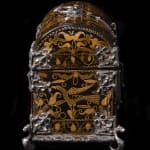BARNIZ DE PASTO, CHEST
Further images
Provenance
Private collection
This chest, based on a European model, is rectangular-shaped with a semi-cylindrical lid. All four sides and lid are densely decorated with plant elements and a range of birds, arranged symmetrically against a black background onto which the varying motifs in the elaborate design have been applied.
The front features two birds facing each other with one wing closed and the other one open. These beautiful creatures are surrounded by varying stylized forms of vegetation resembling a range of Andean rainforest plants with their flowers and buds. The birds are perched on beautiful flowers. The elaborate picture is built up through these flowers and fine branches, lending the scene a high degree of movement and rare compositional complexity. The back presents the same intricate design, with the birds mirroring each other, the only difference being that a great open flower bud is seen rising up in the middle. Stems are growing up from below, unfurling in time with the rest of the flowers of the same variety. The lush appearance of the flora is undoubtedly inspired by the Latin American tropics. The sides both feature a single bird immersed in exuberant vegetation. On the lid we once again observe the central bird motif immersed in a stereotypical tropical rainforest surrounding. This is repeated on the front and back of the lid. Beautiful flower buds seem to sprout out of the intricate branches that surround the birds, thereby building up a bucolic and fantastical image of the Garden of Eden.
The scenes depicted throughout the surface of the chest are framed by decorative borders with fruit and flower bud motifs. These borders are achieved by using mopa mopa resin in such a way as to resemble ribbons of braided cord fabric.
The chest also boasts beautiful corner mounts made of cast silver openwork, featuring symmetrical phytomorphic scrolls at the corners which, like fine filigree, help to further embellish this stunning object. On the back, narrow hinges in the same style join the body to the lid. The keyhole mount is rectangular, made of plain silver with arrow-shaped projected tips at the corners, and presents two orifices, one for the key and the other to house the latch, which is made up of one plain, elongated metal strip with incised motifs. The handle is baluster-shaped with a tip sticking out in the middle and tiny little flowers on the hooks attaching it to the lid.
On the long sides of the inside of the chest there are two protruding wooden half-moons that serve as guides for the curved lid, also acting as dust guards.
The beautiful Andean imagery covering the lid is complemented by the fantastical feet on which the chest is supported. These feature imaginary animals that may be meant to represent the Quechua deity Amaru, who had a head, the legs of an animal and the body of a scaly serpent. Amaru was the deity of water, fertility and wisdom in the Quechua culture, which was deeply-rooted in the central Andean region. These feet are in the shape of a curvy, scaly serpent, with a bare female torso and the face of a fantastical animal, reminiscent of a dragon or some other marine creature present in Spanish bestiaries and heraldry, which leads us to conclude that what we are witnessing here is a marvelous hybrid intercultural encounter.







